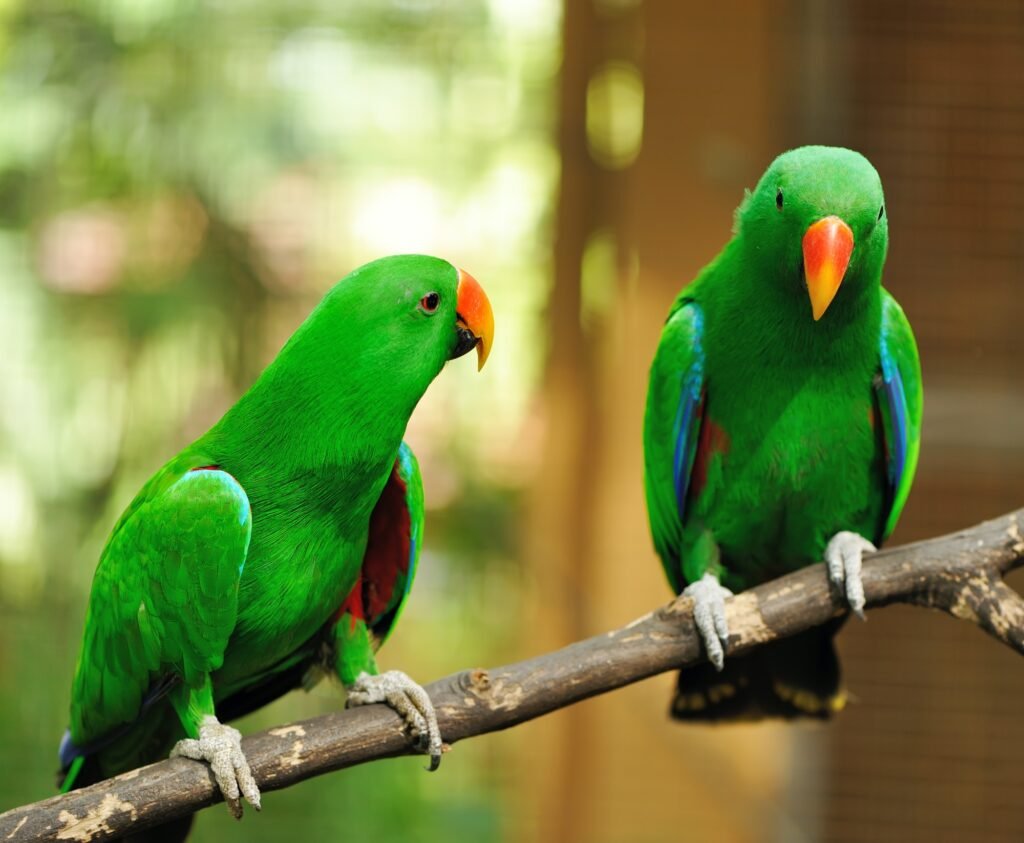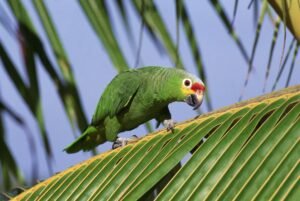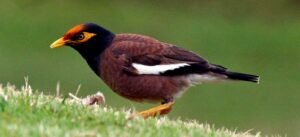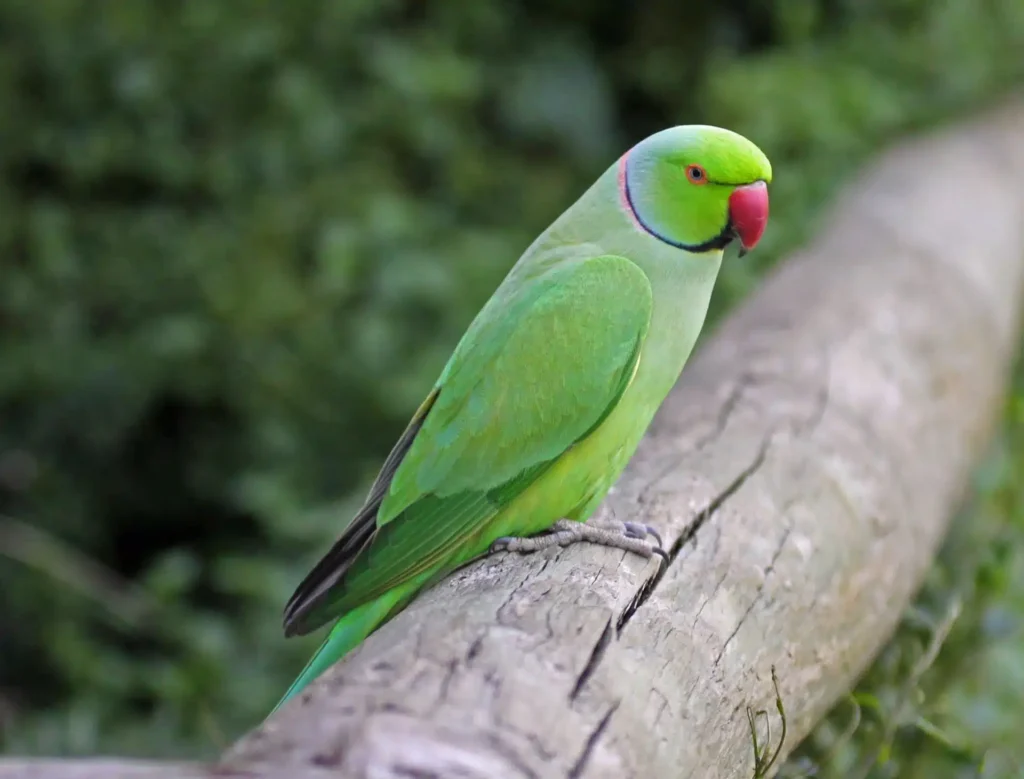Discover the Splendor and Serenity of Eclectus Parrots
Introduction:
Eclectus Parrots (Eclectus roratus) are known for their striking sexual dimorphism, with males and females displaying distinctly different plumage colors. Native to the rainforests of the Solomon Islands, New Guinea, northeastern Australia, and nearby islands, these parrots are highly prized for their beauty, gentle nature, and exceptional talking abilities. Their calm demeanor and vivid colors make them popular pets among bird enthusiasts seeking a serene yet captivating companion.
Male Eclectus Parrots are adorned with bright green feathers, orange beaks, and flashes of red and blue under their wings. In contrast, female Eclectus Parrots are a vivid red with a purple or blue chest and a black beak. This dramatic difference in appearance between the sexes is unique among parrots and adds to their allure. Eclectus Parrots are known for their intelligence, affectionate nature, and relatively quiet disposition, making them suitable for various living environments.
In their natural habitat, Eclectus Parrots live in pairs or small groups, feeding on a diet of fruits, nuts, seeds, and flowers. They require a stimulating environment, a balanced diet, and plenty of social interaction to thrive in captivity. With proper care, these enchanting birds can live up to 30 years, offering long-term companionship and delight to their owners.

Facts:
| Fact | Details |
|---|---|
| Scientific Name | Eclectus roratus |
| Common Names | Eclectus Parrot, Red-Sided Eclectus |
| Year Discovered | 1776 |
| Kingdom | Animalia |
| Phylum | Chordata |
| Subphylum | Vertebrata |
| Class | Aves |
| Order | Psittaciformes |
| Family | Psittaculidae |
| Genus | Eclectus |
| Species | E. roratus |
| Natural History | Native to the Solomon Islands, New Guinea, northeastern Australia, and nearby islands |
| Physical Information | Medium-sized bird, around 35 cm in length, with dramatic sexual dimorphism in plumage colors |
| Appearance | Males: bright green with orange beaks and red/blue underwings; Females: vivid red with purple/blue chest and black beaks |
| Scientists Names | Described by Johann Friedrich Gmelin in 1788 |
| Region | Solomon Islands, New Guinea, northeastern Australia |

Appearance:
Eclectus Parrots are medium-sized birds, typically measuring around 35 cm in length. Males are predominantly bright green with orange beaks and red and blue underwings. Females are strikingly different, with vivid red plumage, a purple or blue chest, and black beaks. This sexual dimorphism is unique among parrots and makes them easily distinguishable.
Distribution:
Eclectus Parrots are native to the rainforests of the Solomon Islands, New Guinea, northeastern Australia, and nearby islands. They inhabit dense forests, mangroves, and woodland areas where they forage for food and socialize in pairs or small groups.
Habits and Lifestyle:
In the wild, Eclectus Parrots are highly social and typically seen in pairs or small groups. They are known for their calm and gentle demeanor. Their diet consists mainly of fruits, nuts, seeds, and flowers. As pets, Eclectus Parrots require regular social interaction, mental stimulation, and a variety of toys to keep them entertained and healthy.
Care Guide:
Caring for an Eclectus Parrot involves providing a spacious cage with plenty of perches, toys, and enrichment activities. Their diet should include high-quality pellets, fresh fruits, vegetables, and occasional nuts. Fresh water should always be available. Regular social interaction and out-of-cage time are essential for their well-being.
Physical Characteristics:
Eclectus Parrots have a robust build with a strong, curved beak. Males are predominantly green with orange beaks and red/blue underwings, while females are vivid red with a purple or blue chest and black beaks. Their expressive eyes and serene demeanor make them visually and temperamentally appealing.
Diet and Nutrition, Foods to Avoid:
In the wild, Eclectus Parrots feed on a variety of fruits, nuts, seeds, and flowers. In captivity, their diet should include a mix of high-quality parrot pellets, fresh fruits, and vegetables. Foods to avoid include chocolate, caffeine, alcohol, avocado, and any foods high in salt, sugar, or fat, as these can be toxic to birds.

Breeding and Business:
Breeding Eclectus Parrots in captivity requires a suitable environment and a deep understanding of their needs. They typically lay 2-3 eggs per clutch, with an incubation period of about 28-30 days. Providing nesting boxes and a nutritious diet rich in calcium and protein is essential for successful breeding.
Behavior:
Eclectus Parrots are known for their calm and gentle behavior. They form strong bonds with their human caregivers and enjoy interactive play. These birds require regular mental stimulation, training, and social interaction to prevent boredom and behavioral issues. They are excellent mimics and can learn to speak and perform tricks.

FAQs:
| Question | Answer |
|---|---|
| How long do Eclectus Parrots live? | Eclectus Parrots can live up to 30 years in captivity. |
| What do Eclectus Parrots eat? | Their diet includes high-quality pellets, fresh fruits, vegetables, and occasional nuts. |
| Where can I see Eclectus Parrots? | They are native to the Solomon Islands, New Guinea, northeastern Australia, and nearby islands, and are popular as pets worldwide. |
| Do Eclectus Parrots talk? | Yes, they are excellent mimics and can learn to speak and perform tricks. |
| How do Eclectus Parrots socialize? | They are social birds that enjoy interacting with their flock or human caregivers. |
Related Birds or Mate:
Related species include other members of the Psittaculidae family, such as the Solomon Islands Eclectus and the Vosmaeri Eclectus, which share similar habitats and behaviors. Eclectus Parrots are often compared to these species due to their striking appearance and social behavior.
Type and Quality Prices:
| Type | Price Range |
|---|---|
| Pet Quality | $1,000 – $2,500 |
| Breeder Quality | $2,500 – $5,000 |

Factors Affecting Price:
Prices can be influenced by factors such as age, health, subspecies, and whether the bird is hand-raised or parent-raised. Geographical location and availability also play significant roles.
Price for the Bird in Different Regions and Countries:
| Region/Country | Price Range |
|---|---|
| United States | $1,000 – $5,000 |
| Europe | €900 – €4,500 |
| Australia | AUD 1,500 – AUD 6,000 |
| Asia | $1,200 – $5,500 |
References:
Categories: Companion Birds, Medium-Sized Parrots, Vocal Birds, Rainforest Birds, Social Birds, Seed-Eating Birds, Pet Birds, Intelligent Birds
Views: 4






